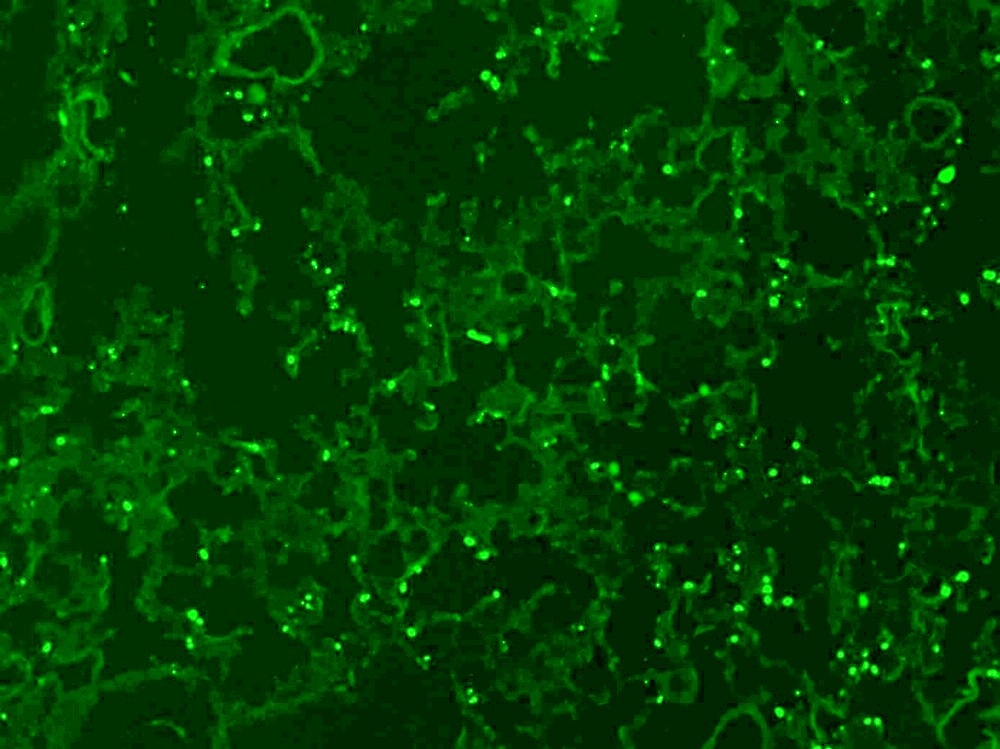


Apoptotic lung tissue cells (green) in DBA/2 mice that died from MA-ARDS (credit: Sabrina Epiphanio/USP).
Published on 08/08/2022
Luciana Constantino | Agência FAPESP – Experiments on mice conducted at the University of São Paulo (USP) in Brazil have revealed one of the mechanisms leading to malaria-associated acute respiratory distress syndrome (MA-ARDS). This potentially lethal complication of malaria is rarely diagnosed soon enough, and kills as many as 80% of the patients affected.
An article on the study, published in the journal Cell Death & Disease, also shows that intervention in this process can reduce mortality and points to an avenue of research on novel treatments for humans.
The experiments involved mice DBA/2 infected with the parasite Plasmodium berghei ANKA. The model mimics several aspects of the human syndrome, such as pulmonary edema, internal bleeding, pleural effusion (water on the lungs), and hypoxemia (low blood oxygen).
According to the article, apoptosis (a form of programmed cell death) contributes to the development of MA-ARDS by facilitating a breakdown in the blood-air barrier (or alveolar-capillary membrane), the area of the lungs where carbon dioxide is exchanged for oxygen.
As the syndrome progresses, apoptosis in the barrier increases vascular permeability. Infected red blood cells (erythrocytes) come into contact with endothelial cells lining blood vessels. Air spaces form between these cells, allowing fluid to leak into the extracellular medium and cause pulmonary edema.
Mice with ARDS displayed higher levels of apoptosis in endothelial and inflammatory cells than control mice. According to the authors, apoptosis is executed by caspases, a family of protease enzymes that regulate cell death mechanisms and inflammation. When mice with ARDS were treated with ZVAD-fmk, a pan-caspase inhibitor, a reduction in apoptosis and edema formation were observed, leading to improved respiratory capacity and lower mortality.
“Our study contributes to a better understanding of one of the mechanisms that lead to the development of MA-ARDS and increased vascular permeability. It also shows that intervening in this process can reduce the mortality rate, which is very high,” Sabrina Epiphanio, a professor in the School of Pharmaceutical Sciences (FCF-USP) and the last author of the article, told Agência FAPESP.
The first and second authors, Michelle Klein Sercundes and Luana dos Santos Ortolan, were supervised by Epiphanio during their master’s, PhD and postdoctoral research. The group also included researchers affiliated with the same university’s Institute of Biomedical Sciences (ICB-USP) and the Federal University of the ABC (UFABC). FAPESP provided funding via five projects (13/20718-3, 15/06106-0, 20/06747-4, 20/03175-0, and 20/03163-1).
“Not many in vivo studies of this type of respiratory syndrome can be found in the literature, and few groups are working on this knowledge area, so the findings of our study are groundbreaking,” said Epiphanio, who has been researching the field for almost 15 years.
MA-ARDS is a severe disease that affects between 5% and 20% of people infected by Plasmodium, and around 80% of those affected die even when given intensive care in a hospital. Its pathogenesis (how it develops in the organism) is poorly understood, and there are no tests or examinations to detect it at an early stage. It is also difficult to study in human patients.
New cases
“The severe acute respiratory syndrome caused by malaria is similar to the SARS caused by COVID-19,” Epiphanio said.
The pandemic disrupted malaria prevention, diagnosis and treatment in several countries, and this resulted in a rise in cases and deaths between 2019 and 2020. According to a report by the World Health Organization (WHO), there were 14 million more cases of malaria in 2020 than in 2019 and 69,000 more deaths, two-thirds of which can be attributed to the disruption.
Malaria is endemic in 97 countries and endangers 40% of the world population. In Brazil, 99% of all cases occur in the Amazon region. The number of autochthonous cases reported in 2020 surpassed 140,000, and 80% were confirmed in 37 municipalities, according to the Ministry of Health. There were 42 deaths in the period.
Considered one of the world’s most prevalent infectious diseases, malaria is caused by five different species of Plasmodium parasite, all of which can lead to MA-ARDS. The most prevalent species are P. vivax, which accounts for 84% of reported cases in Brazil, and P. falciparum, which is the most aggressive. A vaccine to prevent P. falciparum has recently been approved.
The parasite is transmitted by the bite of an infected female Anopheles mosquito. The main clinical symptoms of the disease are high fever, chills, shivering, sweating, and headache. Some patients also experience nausea, vomiting, fatigue and loss of appetite. Treatment involves antimalarials to prevent development of the parasite. In Brazil, these drugs are provided by the SUS, the national health service.
The article “Blockade of caspase cascade overcomes malaria-associated acute respiratory distress syndrome in mice” is at: https://www.nature.com/articles/s41419-022-04582-6.
Source: https://agencia.fapesp.br/39310